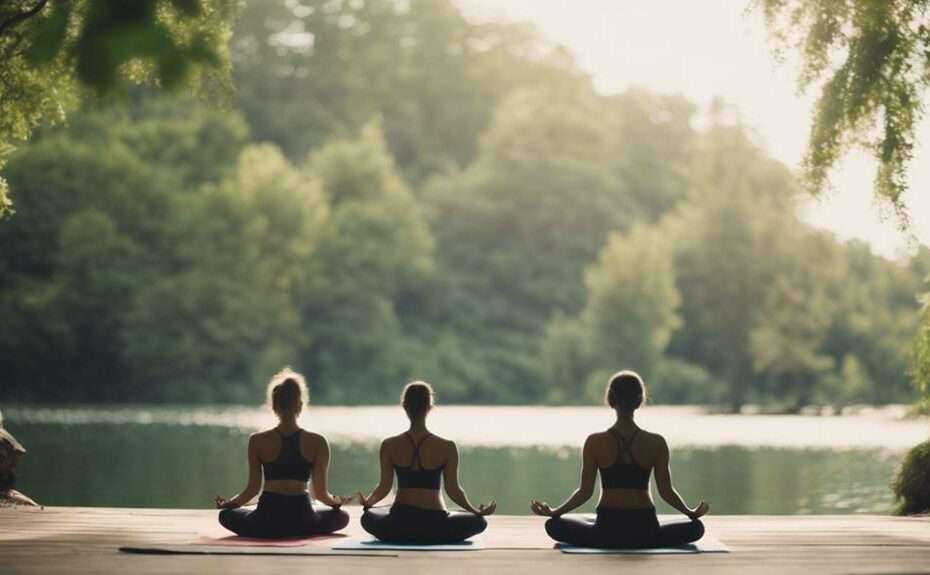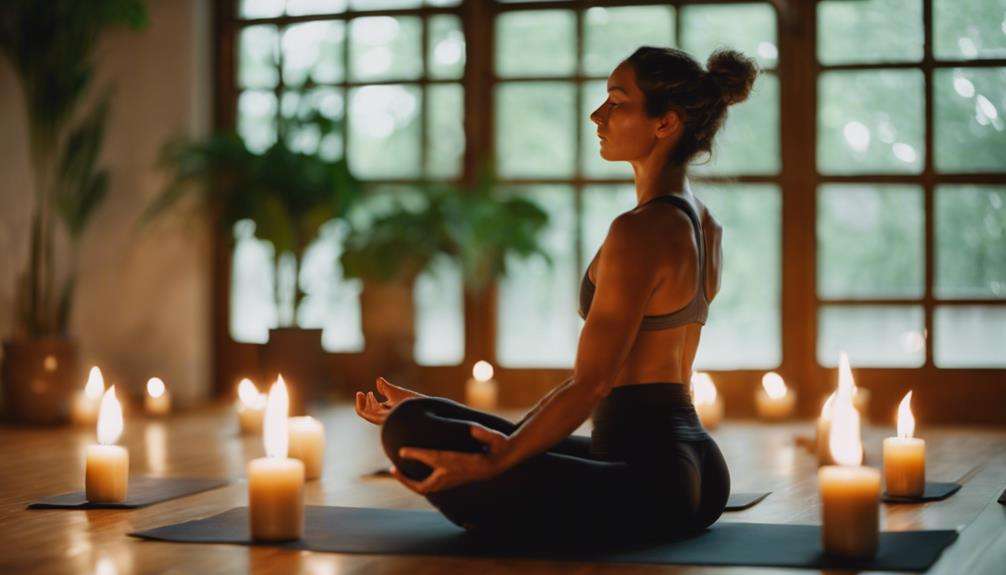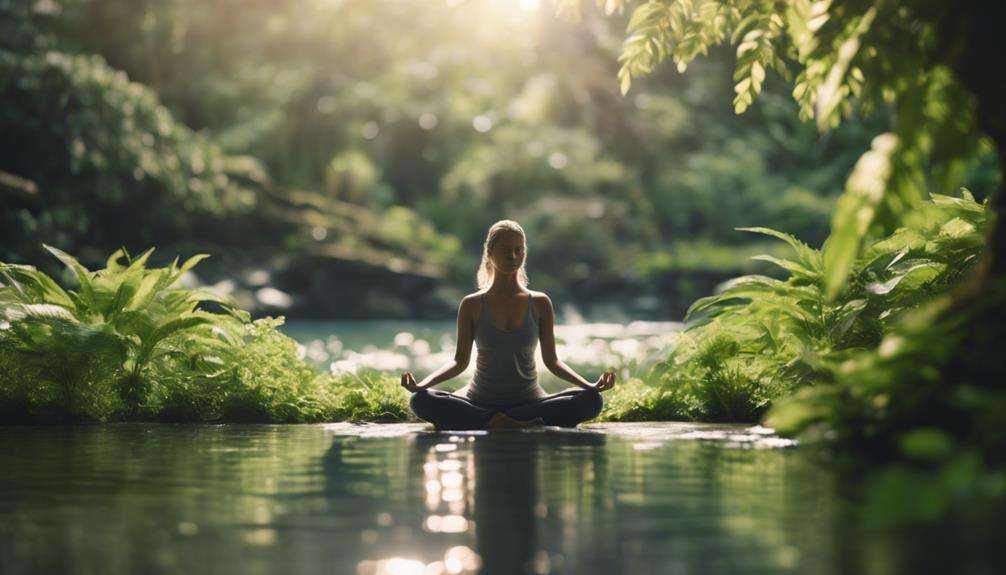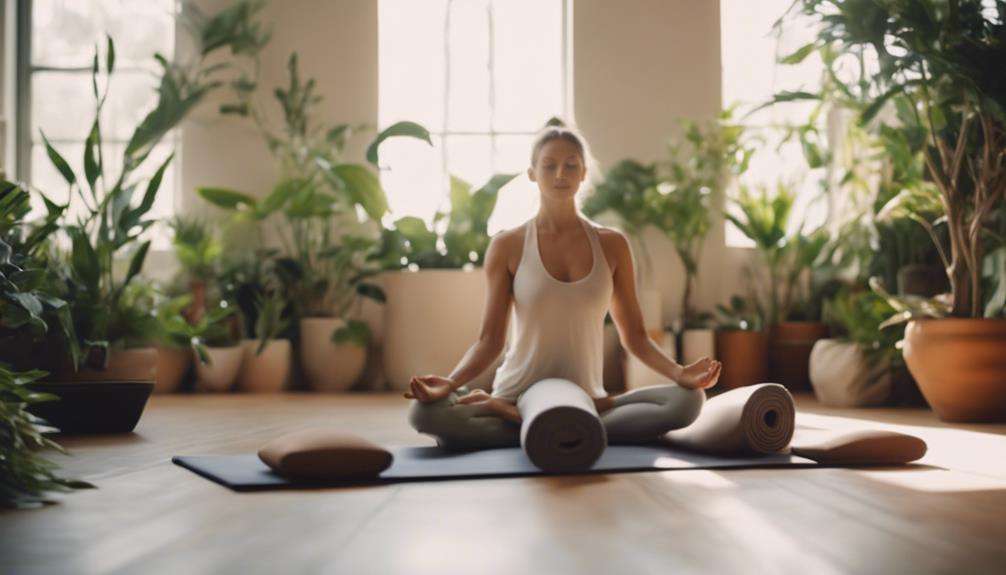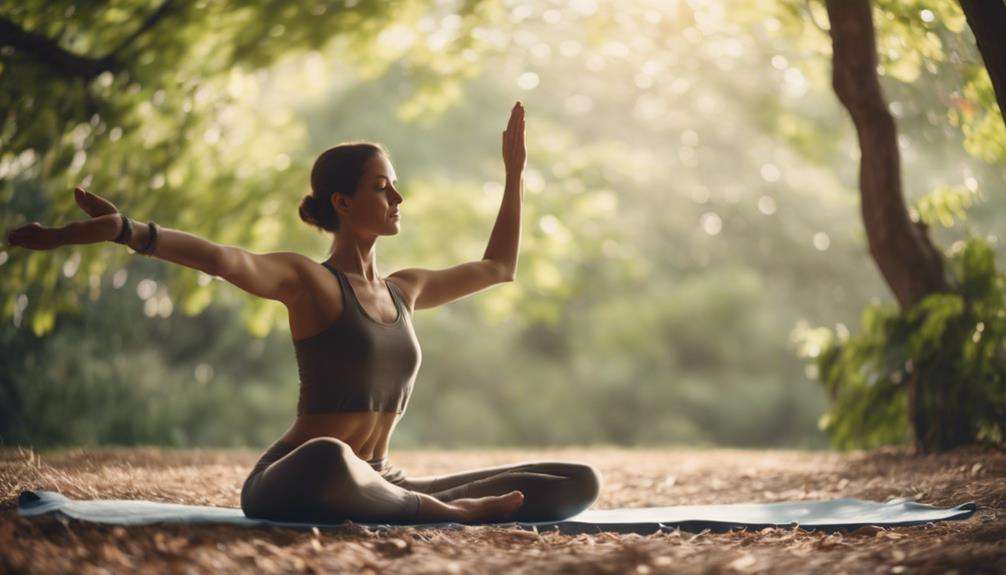When you step into a yoga retreat, the serenity and promise of inner peace envelop you. The gentle rustling of leaves and the distant sound of a singing bowl beckon you towards a journey of self-discovery and well-being.
As you explore the 7 mindfulness practices meticulously curated for your holistic wellness, each breath and movement becomes a gateway to a deeper connection within yourself.
Embrace these practices, and you'll find yourself on the path to enhanced tranquility and self-awareness, paving the way for a transformative experience unlike any other.
Key Takeaways
- Mindful breathing techniques reduce stress and promote relaxation.
- Yoga asanas enhance stability, balance, and presence.
- Nature immersion boosts mood and mental well-being.
- Digital detox improves mental clarity and relaxation.
Mindful Breathing Techniques
Explore the transformative power of mindful breathing techniques during yoga retreats to cultivate inner peace and enhance overall well-being. Mindful breathing, with its emphasis on deep diaphragmatic breathing, serves as a powerful tool for stress reduction and relaxation. By bringing awareness to each breath, participants can tap into the present moment, fostering mindfulness and emotional well-being.
Through the practice of mindful breathing, individuals can regulate their heart rate, lower anxiety levels, and promote a sense of inner calm. This intentional focus on the breath not only aids in relaxation but also enhances concentration and mental clarity. By incorporating these techniques into yoga retreats, participants can experience a profound shift towards inner peace and improved overall well-being.
As you engage in mindful breathing exercises, allow yourself to fully immerse in the sensations of each inhale and exhale. Embrace the stillness that arises, letting go of tension and embracing a sense of serenity. Through the simple act of mindful breathing, you can embark on a journey towards a more centered, peaceful state of being.
Grounding Yoga Asanas
As you transition into exploring grounding yoga asanas, you'll discover the profound impact of rootedness and stability within each pose.
These postures serve as anchors, grounding you in the present moment and fostering a deep sense of connection to the earth beneath you.
Embrace the opportunity to cultivate stability through these grounding poses, allowing yourself to find balance and peace in body and mind.
Rootedness in Poses
Feeling grounded in yoga poses is essential for fostering stability and balance in your practice. When you focus on rootedness, you enhance your connection to the earth, creating a strong foundation for your movements.
In poses like Tadasana (Mountain Pose), follow these steps to experience the full benefits of grounding:
- Engage your feet: Press them firmly into the mat to establish a stable base.
- Activate your legs: Feel the muscles working to support you from the ground up.
- Lengthen your spine: Imagine a string pulling you up from the crown of your head.
- Breathe deeply: Allow the grounding sensation to bring you into the present moment, fostering stability, balance, and presence in each pose.
Stability Through Postures
Establishing stability and balance in your yoga practice is paramount through grounding yoga asanas. These postures, such as Tadasana and Virabhadrasana, help you connect with the earth, enhancing your sense of rootedness and presence.
By engaging in balancing poses like Vrikshasana and Garudasana, you cultivate inner strength and focus, promoting both physical and mental steadiness. Grounding postures not only improve your stability but also benefit your overall well-being by calming the mind and reducing anxiety.
Through the practice of these grounding yoga asanas, you can find a deeper connection with yourself and the world around you, fostering a sense of inner peace and harmony. Embrace these postures to ground yourself and enhance your inner balance and presence.
Body Scan Meditation
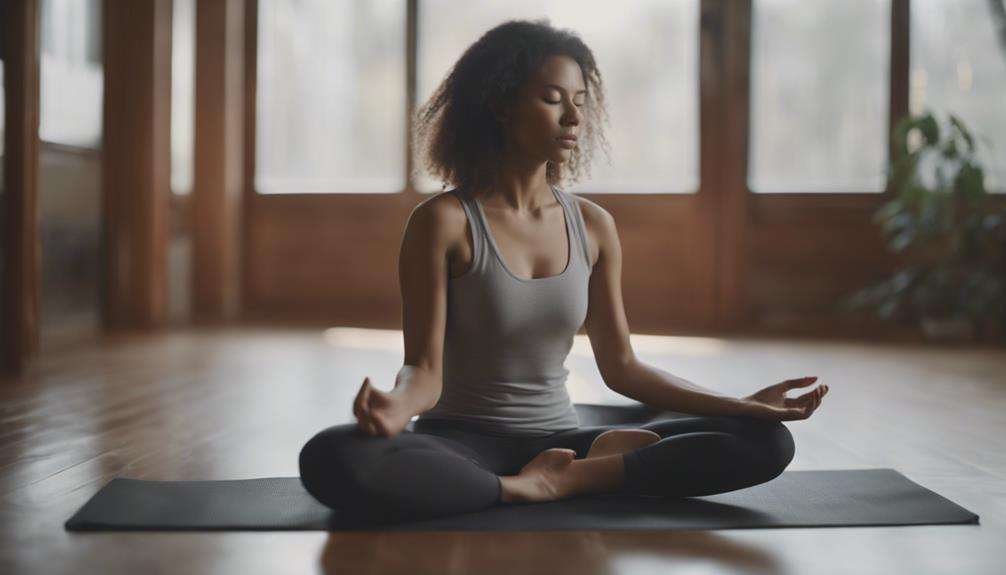
Embark on a journey of self-discovery and relaxation through the transformative practice of body scan meditation. This mindfulness technique involves systematically focusing on different parts of your body, starting from your toes and moving upwards. By tuning into physical sensations, body scan meditation enhances body awareness, relaxation, and mindfulness.
Here are four key benefits of incorporating body scan meditation into your routine:
- Enhanced Self-Awareness: By bringing attention to each body part, you develop a deeper connection with yourself.
- Stress Relief: Identifying areas of tension and releasing stress can promote overall well-being and relaxation.
- Improved Sleep Quality: Research suggests that regular body scan meditation can help reduce anxiety and improve the quality of your sleep.
- Accessible Practice: Whether you choose to practice body scan meditation lying down or seated, it's suitable for individuals of all abilities.
Incorporating body scan meditation into your daily routine can lead to a greater sense of well-being and inner peace.
Mindful Walking in Nature
Immerse yourself in the tranquil beauty of nature as you practice mindful walking during your yoga retreat. Mindful walking in nature involves focusing on each step, breath, and sensation, allowing you to enhance your awareness and presence in the moment. By connecting with the natural environment, you can reduce stress and anxiety, promoting relaxation and inner peace.
Engaging in mindful walking encourages grounding and mindfulness through sensory experiences unique to nature. The rustling of leaves, the chirping of birds, and the feel of the earth beneath your feet all contribute to a sense of calm and connectedness. This practice not only benefits your physical well-being but also improves mental clarity, offering a reprieve from the hustle and bustle of daily life.
As you walk mindfully in nature, allow yourself to fully appreciate the surroundings. Let the beauty of the landscape guide you towards a state of profound relaxation and rejuvenation.
Gratitude Journaling Practice

As you embark on your gratitude journaling practice, you open the door to a world of positivity and self-discovery.
By reflecting on the things you're thankful for, you invite more joy and contentment into your life.
This simple yet powerful practice can help you cultivate a mindset of gratitude and elevate your overall well-being.
Benefits of Journaling
Gratitude journaling, a transformative mindfulness practice, holds profound benefits that can enhance your well-being and foster a positive outlook on life. Engaging in this practice during a yoga retreat can have a significant impact on your mental and emotional wellness. Here are some key benefits of gratitude journaling:
- Promotes Positive Emotions:
Writing down things you're thankful for can boost your mood and increase feelings of happiness.
- Enhances Relationships:
Expressing gratitude in your journal can improve your connections with others and foster a sense of empathy.
- Reduces Stress:
Reflecting on gratitude can help lower stress levels and promote relaxation during your retreat.
- Increases Self-Awareness:
Keeping a gratitude journal can deepen your understanding of yourself and your surroundings, leading to greater self-awareness.
Techniques for Gratitude
To cultivate a deeper sense of gratitude through journaling practice, consider starting each day by reflecting on the things you appreciate in your life.
Gratitude journaling is a powerful tool that not only enhances your mental health but also boosts self-awareness, well-being, optimism, and resilience. By regularly jotting down what you're thankful for, you're training your mind to focus on the positive aspects of your life.
Research indicates that this practice can reduce symptoms of depression and anxiety, leading to a more balanced and contented state of mind. Engaging in gratitude journaling during yoga retreats can further deepen your mindfulness practices, supporting emotional healing and personal growth.
Embrace the practice of gratitude journaling to nurture a brighter outlook on life.
Daily Journaling Routine
Enhance your daily journaling routine during a yoga retreat by incorporating gratitude journaling to boost mindfulness and self-reflection. Gratitude journaling can significantly impact your well-being by reducing stress levels and promoting emotional healing.
Here's how to make the most of this practice:
- Increase Positive Emotions: Reflecting on things you're thankful for each day can enhance your overall mood and mindset.
- Cultivate Gratitude: Keeping a gratitude journal helps you appreciate the present moment and fosters a sense of thankfulness.
- Track Progress: Regular journaling allows you to track your personal growth, insights gained, and mindfulness journey during the retreat.
- Enhance Self-awareness: Journaling practices promote self-awareness, emotional healing, and deeper connections with your yoga retreat experience.
Loving-Kindness Meditation
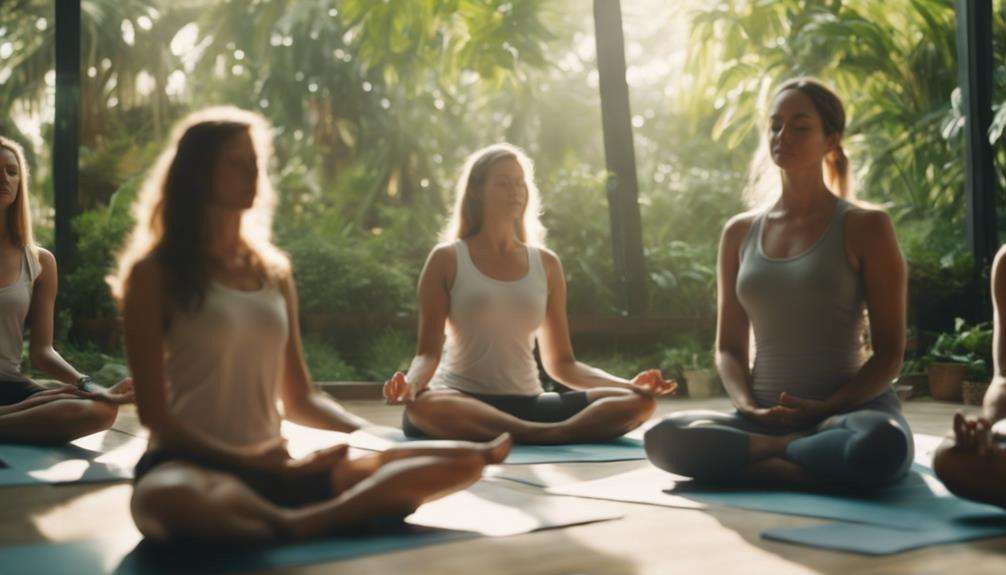
Loving-Kindness Meditation, also known as Metta Meditation, is a transformative practice that cultivates feelings of love, kindness, and compassion towards oneself and others. By engaging in this meditation, you can promote your well-being, happiness, and peace.
Research suggests that this practice can reduce symptoms of depression, increase positive emotions, and enhance social connections. Through the repetition of loving phrases or mantras, you can foster empathy and goodwill, leading to improved self-esteem, reduced anger, and a deeper sense of interconnectedness with those around you.
Regular practice of Loving-Kindness Meditation can contribute to emotional resilience, enhance empathy, and boost overall psychological well-being. Embrace this powerful technique to nurture a more compassionate heart, strengthen your relationships, and cultivate a positive outlook on life. Take this opportunity to deepen your connection with yourself and others through the practice of Loving-Kindness Meditation.
Digital Detox and Silent Retreat Time
Disconnecting from technology and embracing silence can profoundly enhance your yoga retreat experience, allowing you to deepen your mindfulness practices and cultivate inner peace. During your retreat, consider the following to make the most of your digital detox and silent retreat time:
- Reduce Stress: By disconnecting from technology, you can reduce stress levels and create space for relaxation and mental clarity.
- Enhance Mindfulness: Silent retreat time allows you to immerse yourself in meditation and mindfulness practices without the distractions of technology.
- Improve Mental Health: Research suggests that reducing screen time can have a positive impact on mental health and overall well-being.
- Promote Inner Peace: Embracing silence during retreats promotes introspection, self-reflection, and a deepening of mindfulness practices, leading to a sense of inner peace and rejuvenation.
Frequently Asked Questions
How Do You Practice Mindfulness While Doing Yoga?
Focus on breath awareness to stay in the present moment during yoga. Connect with your body through mindful movements. Practice meditation for inner peace. Use mindfulness techniques for self-reflection. Embrace the power of yoga to cultivate mindfulness and enhance well-being.
How Does Yoga Promote Mindfulness and Self-Awareness?
How can yoga enhance your self-awareness and mindfulness? By focusing on breath awareness, body scan, and the mind-body connection, yoga grounds you in the present moment, fostering inner focus, sensory awareness, and self-reflection.
What Is the Best Yoga for Mindfulness?
For cultivating mindfulness, consider Hatha or Yin yoga for gentle movements. Embrace Mindful Vinyasa to sync breath with movement. Kundalini integrates breathwork, meditation, and chanting, promoting inner stillness. Restorative yoga facilitates deep relaxation. Mind-body connection strengthens, enhancing self-awareness.
What Is the Relationship Between Yoga and Mindfulness?
You understand the intimate relationship between yoga and mindfulness. Mindful movements, meditation practices, and mindful breathing in yoga enhance the mind-body connection. Embodying these principles fosters self-awareness, personal growth, and holistic well-being.
Conclusion
As you continue to explore these mindfulness practices in yoga retreats, you'll uncover a world of inner peace and transformation waiting to be embraced.
Each breath, each step, each moment of awareness will lead you closer to a deeper sense of well-being and connection.
Keep immersing yourself in these practices, and watch as the magic of mindfulness unfolds before your eyes, transforming your mind, body, and spirit in ways you never thought possible.
Embrace the journey ahead with an open heart and a curious mind.
